Occasionally, if I’m not producing certain vegetables in the garden, my wife buys them at the grocery store. She’ll buy some peppers in winter, for example, or cauliflower in summer. But never do we buy tomatoes.
Tomatoes that aren’t home grown aren’t worth eating.
If you’re a gardener, you know that. Here’s what I know about how to grow your own tomatoes so that, at least during summer and fall, you don’t have to buy tomatoes at the grocery store.
Sow seeds or plant seedlings?
Most people grow their tomatoes by buying plants to transplant into their garden.
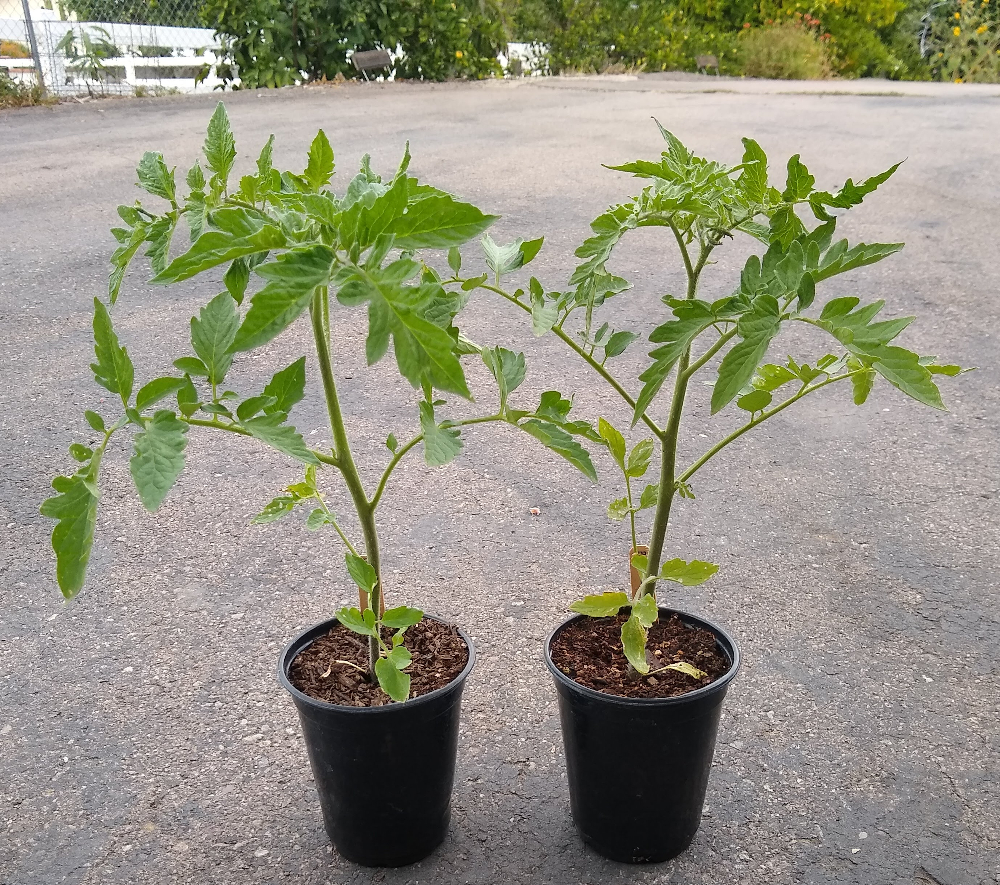
Sowing tomato seeds gives you some advantages though, including access to more varieties and control of timing and stock.
When to plant tomatoes in Southern California
If you grow your tomatoes from seed, then you can sow them in containers 1-2 months before you intend to plant them. Or, you can sow the seeds directly in the garden ground around the same time that you would put in transplants.
When is that? In Southern California, after mid-March is usually a good time to put in your first tomato transplants. And July 4th is about as late as you should plant tomatoes if you want to get a full crop before the weather cools in late fall. (Late May is the latest I’d sow tomato seeds.)
Here is what happened to my tomato plants one year when I planted them before the weather was right: “I planted tomatoes too early.”
Technically, you can grow tomatoes year-round in most parts of Southern California since the weather rarely gets cold enough to kill plants. I often let one or two of my cherry tomatoes go through the winter since such small-fruited types ripen better in the cool weather.
If you’re close to the beach, then in some years you get a lot of May Gray and June Gloom such that it might be smartest for you to wait until May or June to plant varieties with big fruit so that they are ripening that fruit when the summer heat finally arrives starting in July.
Two rounds of tomatoes in Southern California
Our warm season lasts so long in Southern California, that we have time for multiple tomato plantings. I’ve settled on two main rounds: an early and a late.
I plant a group in March or April, which I’ll start eating from in late May or early June. And then I plant a group around June that gives me fruit through the fall.

One reason to do this is that tomato plants started in April are unlikely to still be growing well and producing lots of tomatoes in the fall. It happens, but most of those early tomatoes decline starting around August – due to powdery mildew, mites, some soil-borne fungus, etc.
Find more nuances about when to plant tomatoes in Southern California in my post on the topic.
Planting tomatoes
When you plant tomatoes you can bury part of the stem because tomatoes make adventitious roots. In other words, when you bury a tomato stem it grows roots along the stem. Some people even think that burying the stem of a tomato plant is the best way. I’ve never noticed that it makes a difference. That being said, if a plant is tall and wobbly then you can bury it deep in order to help it stand erect.
Spacing tomatoes
Most farmers space their tomato plants 18 inches apart down a row, except for cherry types, which are planted more like two feet apart since those plants are bigger. I also use this spacing when I support them into an upright shape. If you’re letting your tomato plants sprawl, then you need to space them out more – up to four feet between plants.
Supporting tomatoes
Tomatoes do not need to be supported. You can let them grow naturally, like bushes that sprawl on the ground.
The advantage of this is not having to put in the time and effort of supporting the plants. The disadvantages are that the plants take up more ground space, some of the fruit lies on the ground and is sometimes munched by bugs, and harvesting is harder because you must step into the bush to get fruit in the middle. One year I grew a Sungold cherry tomato plant without support, and that single plant became a jungle. Every time I entered the jungle to pick fruit near the middle, I came out smelling like tomato vine for hours.
So these days I usually stake-and-string my tomatoes or put large cages around them.
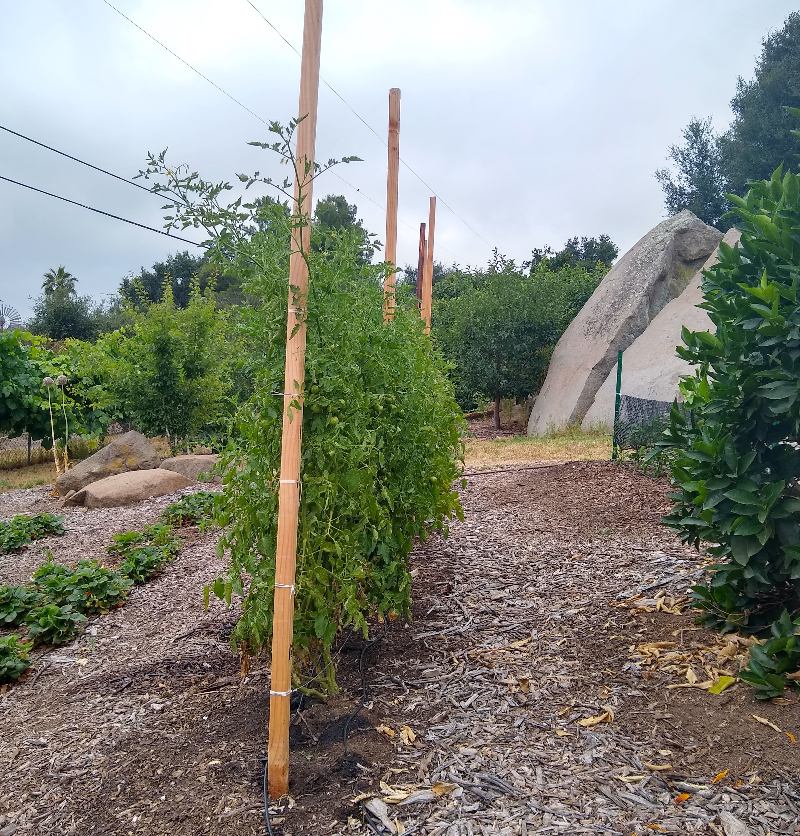
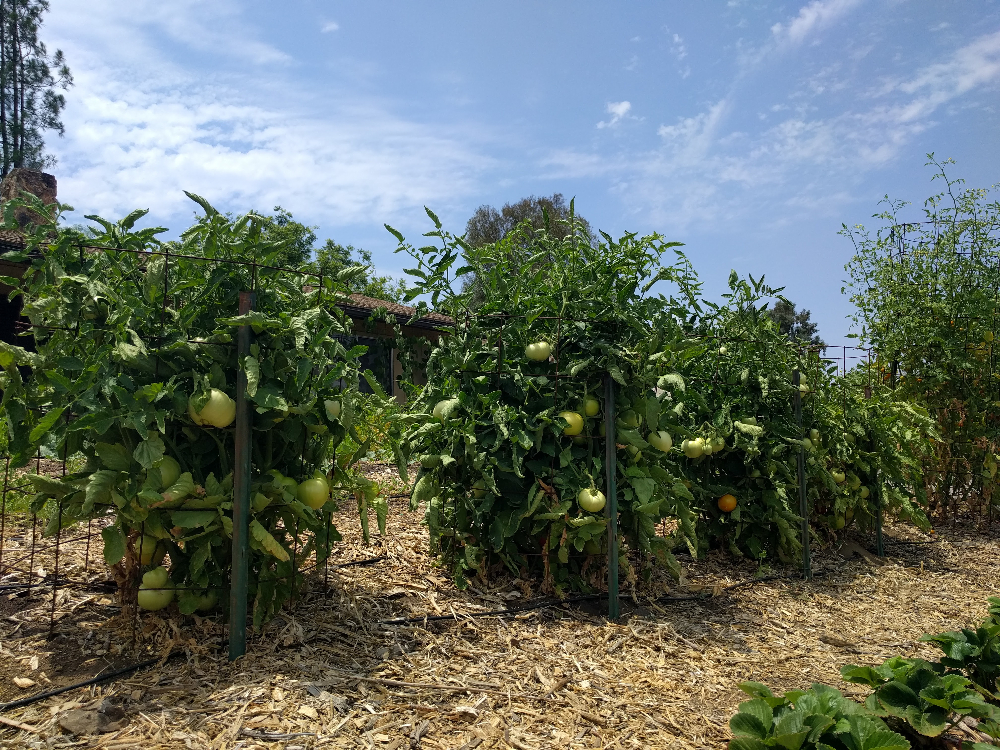
Have a look at this post for pros and cons of these two methods of supporting tomatoes: “Comparing tomato supports: cage versus stake-and-string.”
Pruning tomatoes
The only time I prune tomatoes is to get the plants and fruit up off the ground. So I’ll cut off some lower stems so that the plant branches out higher up and therefore keeps its fruit higher up. This makes supporting and harvesting easier.
Harvesting tomatoes
You don’t need to wait to harvest a tomato until it has full color on the vine in order for it to have full flavor. You can pick it a bit earlier than that and let it finish ripening on the kitchen counter.
How early can you pick a tomato? In order for it to turn full color – red, usually – it must have some of that color in the skin when you pick it. In other words, if a regular red tomato has some red blush on the skin, you can pick it and it will fully color to red off the vine. You cannot, however, pick the tomato green and get it to turn red off the vine.
There’s no need to pick a tomato before it has reached full color on the vine, but there are a couple of advantages to doing so. One is that it makes it more likely that you will eat the fruit before a critter does. A second is that it makes it more likely that you will harvest the fruit before the skin cracks or it gets sunburned.
I used to wait to pick my tomatoes much longer than I do now. These days I find myself harvesting earlier due to the reasons above.
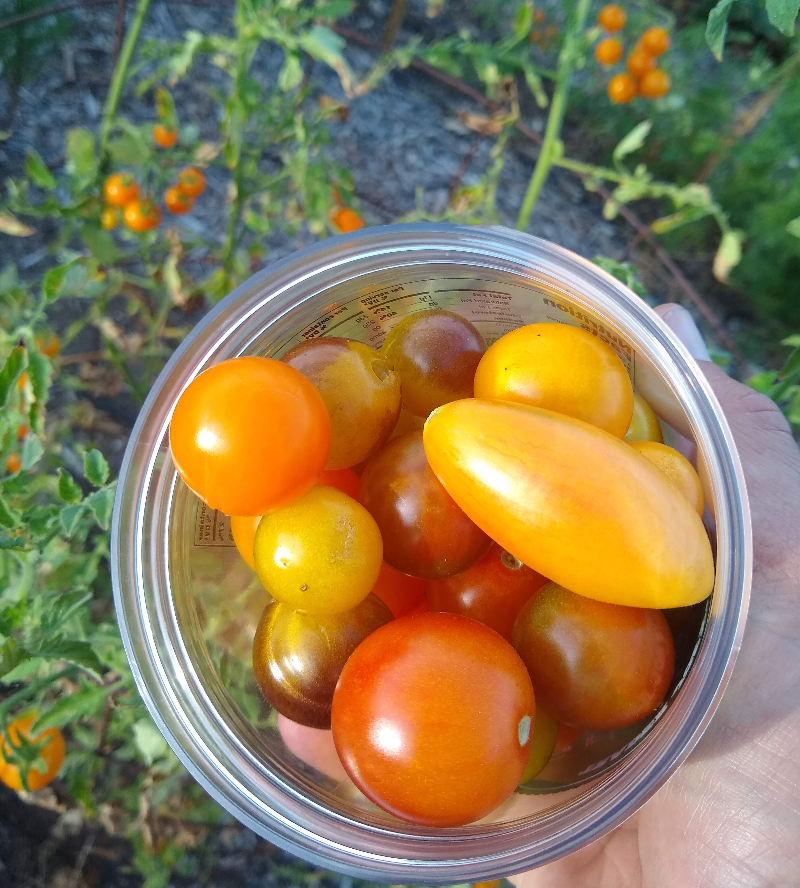
Which tomato varieties do best in Southern California?
Everyone who has been growing tomatoes for a while has settled on favorite varieties that they grow every year – because they like the taste and because the plants produce well for them – but everyone’s favorites are different.
Here are some varieties that are the favorites of local, seasoned tomato growers whom I know.
Cherries: Sweet 100, Nova, Valentine, Sungold.
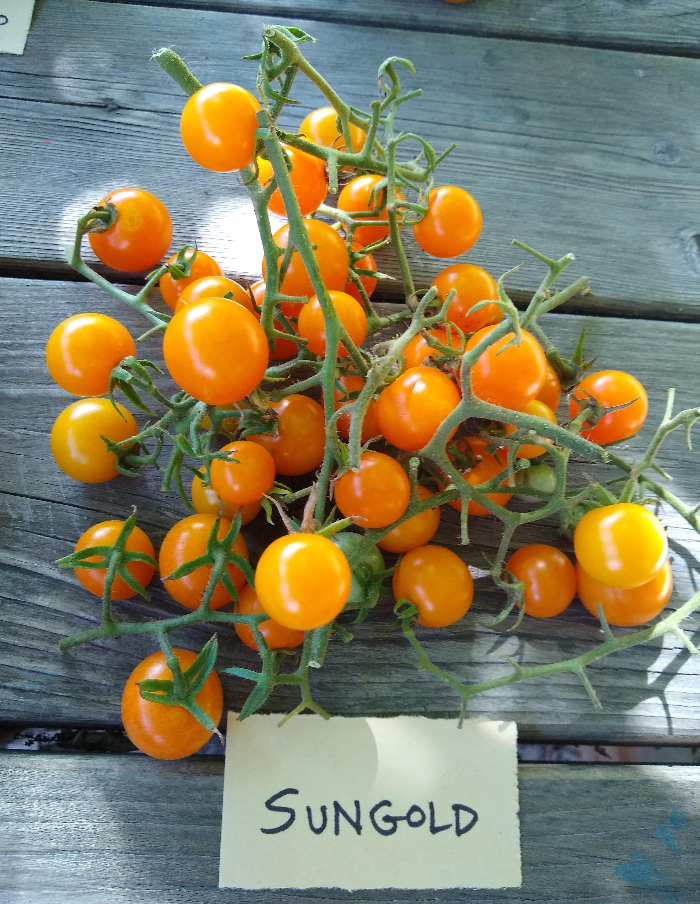
Plums: Blush, San Marzano.
Slicers: Big Beef, Early Girl, Champion, San Diego, Mountain Fresh, BHN 1021, Momotaro.

Heirlooms: Cherokee Purple, Pineapple, Striped German.
See details on a handful of varieties that grew well in my garden a few summers ago: “Tomato varieties for Southern California, 2019”
See details on a handful of varieties that I’ve found do well in soil infested with root-knot nematodes: “Tomato varieties with disease resistance for Southern California.”
(What’s an heirloom tomato? See this post.)
Protecting tomatoes from sunburn, pests, and diseases
Every year, the weather, pests, and disease pressures are slightly different in a garden, and you shouldn’t expect perfect tomato plants like you might see in a blog or vlog. Those are faked. Not even the best farmer grows perfect tomatoes.
Here are some of the many ways that my tomatoes and those of others in Southern California go wrong: “Failing at tomatoes.”
And here is a post I wrote about solutions for some of the most common issues that we deal with on tomato plants in Southern California, including mid-summer decline, blossom end rot, skin cracking, sunscald, root knot nematodes, powdery mildew, mites, critters eating tomato fruit, and plants that don’t produce fruit. The post is called, “Succeeding at tomatoes.”
If you live inland, you’re likely to get sunburn on some tomato fruit during heat waves. Here’s a video of how I protect my tomatoes from heat:
Watering tomatoes
The only way in which watering tomatoes is different from watering any other vegetable in your garden is that it can be done with more volume and less frequency because of the tomato’s extensive root system. Watering tomatoes doesn’t have to be done with more volume and less frequency though.
I’ve used all sorts of watering schedules for tomatoes over the years, from daily to never. (Really, I’ve tried never watering tomatoes. See, “Unirrigated fruits and vegetables in Southern California, summer 2019.”)
While I have seen a difference between a tomato plant’s performance when watered daily versus never, I haven’t seen a difference between those watered daily and those watered about weekly. As long as the right quantity of water is given or available to the plant, then any frequency of application between those extremes is effective in most soils (containers are different).
What’s the right quantity of water to give to tomatoes? This will depend on a few factors, such as how big the plant is and how far inland your garden is (that is, how hot your location is in summer). But here’s a starting point:
Give a mature (large, holding fruit) tomato plant about 7 gallons of water per week in summer.
In spring or fall, give such a plant a bit less. If you’re within a couple miles of the beach, give it less. If the plant is smaller and not yet holding fruit, give it less. If the plant is a large, cherry type, it might need closer to 10 gallons per week in August.
I’d split that watering into two or three applications. In other words, for example, for a mature plant in July you could water 2.5 gallons (the quantity that a large watering can holds) on Monday, Wednesday, and Friday – for a total of 7.5 gallons for the week.
See how the plant does and adjust accordingly.
Fertilizing tomatoes
I’ll tell you what my routine is regarding tomato fertilization, as well as what others do and recommend. I personally don’t treat tomatoes any differently than my other vegetables. I continually add compost and only compost to my vegetable beds for fertility; this compost contains chicken manure; and that’s all I do. My results are generally good, but maybe they can improve by incorporating some of the advice of others.
The California Master Gardener Handbook recommends fertilizing tomatoes this way: “Sidedress plants with nitrogen fertilizer when they set their first fruit and every 4 to 6 weeks thereafter . . . If some form of manure was used at planting, reduce the fertilizer rate by one-half.”
Just today I spoke to my tomato guru, Roy Wilburn, about his fertilization practices. Roy has farmed tomatoes for decades in Southern California and Baja California. His current routine is to use no chemical fertilizers, but rather to amend a bed at planting time with compost, chicken manure, worm castings, and BioFlora Dry Crumbles 6-6-5. The BioFlora contains bone meal, chicken manure, sulfate of potash, and seaweed.
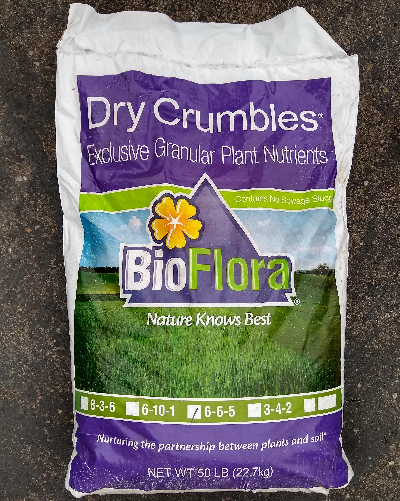
Roy then sidedresses the plants with BioFlora about the time they make their first flowers, and then approximately every two weeks after that, depending on how the plants are performing.
One additional thing that Roy does is add beneficial nematodes to the planting hole of every tomato. He uses the product called, “Fungus Gnat and Root Knot Exterminator,” which contains the nematode species Steinernema feltiae, and which can be purchased at a good retail nursery.
Roy gets phenomenal yields from gorgeous tomato plants, year after year. Each year I find myself more closely emulating many of his tomato growing practices because of the results they produce.
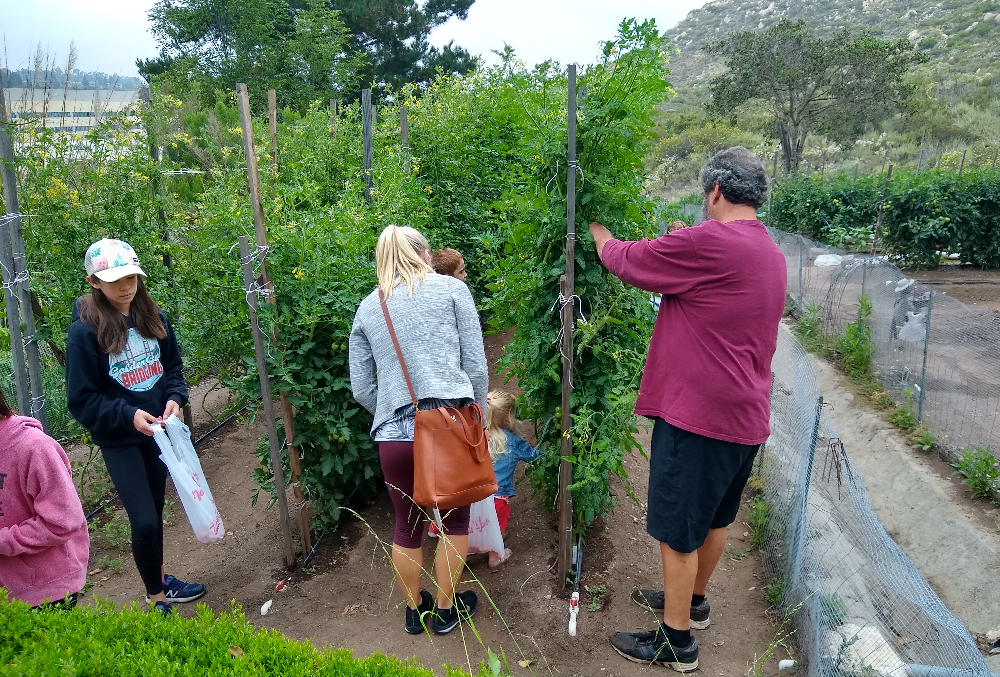
Tomatoes in containers
I have grown many tomatoes in containers over the years, and I grew a handful in containers last year. Richer, more expensive potting soil grows better tomato plants, in my experience. It’s worth the money to fill your pots with the good stuff. I often use my own compost, but Recipe 420 is one mix that you can purchase and that I got good results from last year.
And since tomatoes are big plants, don’t skimp on the container size. Using a five-gallon container is sufficient when the plants are bearing their first fruit, but ultimately the plants should be in a 15-gallon container or a half-wine barrel once at mature size. Bigger containers also allow you to water less often.
Here’s to tomato season!
Thanks for your support so I can keep my Yard Posts coming and the ads away!
All of my Yard Posts are listed HERE

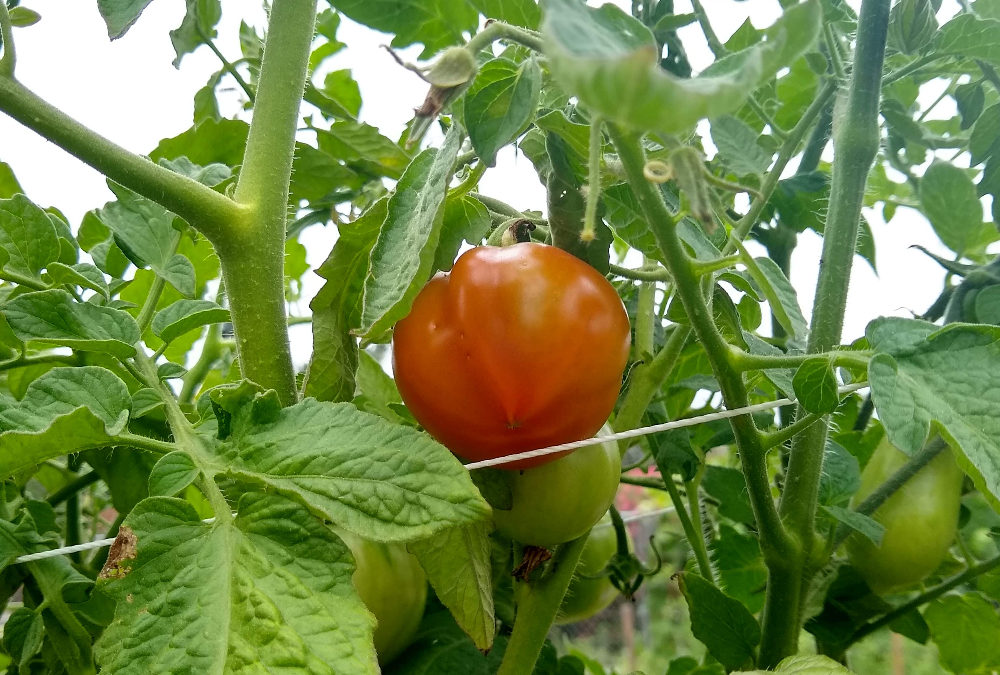


Hi Greg, I look forward to your Friday posts every week – so thank you! You’ve finally convinced me to try a bag of Recipe 420 this year. I’ve been reluctant to try it previously because of the higher cost. For the container tomatoes/vegetables you’ve used this for, do you add any additional amendments or fertilizers during the growing period or do you find that the soil alone is all you need? Thanks.
Hi Doris,
Unfortunately, last year was my first time growing tomatoes in Recipe 420 and they were planted late in the summer so they didn’t truly go a whole season. But the plants did well with nothing added for about half a season. I would guess the plants would benefit from something added later in the season, but I can’t say for sure.
Hi Greg, my beds are weed free at the moment, and I need to purchase mulch. I’ve usually purchased bags, but am thinking that a company that drops it off might be less expensive. What are your thoughts, and how would I find a source? Thanks so much for your posts, they are quite helpful! Laurie
Hi Laurie,
Check out this post: https://gregalder.com/yardposts/where-to-get-wood-chips-for-mulch/
Another question Greg. Am I specifically looking for wood chip mulch? Thanks.
“You cannot, however, pick the tomato green and get it to turn red off the vine.”
There are some terrific green tomato recipes, however (not just fried green, either). I pick some very green, slice and salt in a colander for an hour or two. Mix with garlic, pepper, olive oil and a little spice (usually oregano) stacked in a crock, top off with olive oil and wait a week. In a roll sandwich all by themselves (no meats), they’re delicious and last weeks under the olive oil. Be sure to let as much olive oil drain as possible (by fork) before laying on the roll.
I have a very clay-like soil in Irvine. I use a moisture meter and otherwise would have been watering tomatoes waaay more than needed. Compost seems to be enough for root chow but I’ll add a little urea. My experience: Don’t let the introduced Argentine ants get on your tomatoes. They bring aphids that they “milk.” The aphids carry tomato viruses that are devastating. Native ants (very small) seem fine.
Fantastic comment! I looked up whether earth worms eat nematodes and they do. I often include a few worms from my bin along with their castings. Worms seem to keep the soil free of pathogens, at least the ones small enough for them to eat.
Hi Greg. Where do you purchase the half wine barrels?
Hi Ceridwen,
I’ve seen them for sale at nurseries and hardware stores and home improvement stores.
Hi Greg,
A while back, one of your readers was having trouble with her tomatoes growing slowly and seem to have little life. You suggested trying a sunscreen cloth (70:30) to remove or reduce the effect of heavy sun. I decided to put this cloth over my three 15 gal Heirloom tomato plants, which had been struggling. OMG, in a month they looked like “Charles Atlas” had taken over. They are 6 feet tall, full body plants with a deep green color and the new offshoots are producing beautiful fruit with the traditional heirloom red brown color. I strongly suggest that any of your readers experiencing the same problem give the sunscreen cloth a try.
Bob
Hello Greg,
Last year I had 3 tomato plants in a raised bed. They all started getting dried-up leaves at the bottom, even before there was any ripe fruit and the top of the plants was still growing. Any suggestion as to how to minimize the drying up of older leaves?
Thanks, Bill
In San Diego county, can you harvest tomato seeds to use the following year?
Hi Darr,
Sure you can. I let them sit in a cup of water for a few days and then collect the seeds that have settled on the bottom. I put those on a napkin to dry. Then they’re ready to plant whenever you need.
Hey Greg,
Have you found some varieties to do better in the fall? This year I planted some heirloom seedlings and slicer seedlings that I purchased. They grew over summer a ton but produced very little until the fall came around. I have picked several of each in the last few weeks. I’ve never let tomatoes go this long and find it interesting they’re doing so well. I’m in the Inland empire area and it has been warm this year. Thanks for all you do. Your help has been a game changer in my garden.
Hi Andie,
Maybe those varieties had trouble setting fruit during the high heat of summer but found temperatures more to their liking during fall. I only have three varieties growing now (through fall and into early winter) and while they did set some early fruit in summer, they set lots more during fall when temperatures were warm but not scorching like in summer. I read that the flowers of some varieties are more sensitive to high heat in terms of being able to set fruit.
Great to hear about this. We haven’t bought a tomato in over 6 months and I’d love to continue that year after year. I’ll definitely be keeping track of which varieties did well and when.
In North Park, last spring a friend of a friend gave me 6 healthy little plants (unknown variety). Repotted them. Several months pass, they are healthy but not mostly unchanged until Sept/Oct when they woke up. Repotted several more times as their vines covered the fences and grew around the cacti, Plumeria, Birds of Paradise, everything! I braced with poles, twine, and clips – stunned that they kept getting bigger.
Nice yellow, orange stripes (some medium red) fist-sized fruit. I would have pruned more aggressively had I known how much gusto these guys had in them. Now in late February they’ve begun slowing – but these vines are a knotted mess. Recent storms have cracked some vines and need some deeper pruning.
I’m keeping the thick strong undamaged base vines, but can you offer any insight about pruning or keeping the longer healthy creepers 8-10′? I’m keeping them for now, but wondering if there’s any value in letting the plant start fresh (as if we had a “winter” season)?
Many thanks
Are you familiar with Tomatomania events? On April 6/7 they are doing a free event (held at ForageFlorals) targeting tomato gardeners around Santa Ynez with Mark Donofrio of The Starter Farm giving free clases and advice. For more info reach out to me at arlene@winnick.com
Trying four new tomato heirloom varieties this year. Read that sprouting tomato seeds in toilet paper instead of paper towels reduces seedling root damage. Well my tomato seeds are going to encounter toilet paper sooner or later, so might as well get them used to it!
Ha! Randy, your comments are killing me lately! Thanks for bringing the funny!
Hi Greg: 1st off I received your calendar in the mail and read it cover to cover. A lot of good concise info; it’s in use already. On Tomatoes, cant wait for this year’s Post. I plan to mimic most of what you’ve written about Farmer Roy in hopes of a great crop. In your and Roy’s soil mix “compost” is always mixed in. I dont have a compost bin or make my compost. How can I somewhat duplicate compost? Mix GROMULCH with Composted chicken manure? Do I also need peat moss? Any recipe or info would help. I watched the “tomato support” video and decided I’m going to try that method this year with the string and post method with the Florida/Basket weave. Went to Home Depot and got my supplies. Thank you Joe Oside
Hi Joe,
There are so many sources for compost that it can be hard to choose, but every good nursery will sell bags. Also, since you’re in Oceanside, you can consider getting some at El Corazon: https://agriserviceinc.com/el-corazon-wm/
No need for peat moss. I’ve never used Gromulch, but I know others who use it with good results. Mixing composted chicken manure with the compost is a fine idea, and it happens to be what I do. Well, in truth, it is what my chickens do.
Greg, your introductory comment that “tomatoes that aren’t home grown are not worth eating” gave me a chuckle and had me immediately humming Guy Clark’s song “Home Grown Tomatoes” https://www.youtube.com/watch?v=9tj4wIKMqEE. Thanks, Tim
Greg, I have grown Midnight Snack (like cherry tomatoes) the past 2 years and get incredible yield. My plants kept on growing because I was out of town a lot and I have lots of flowers but the current black tomatoes have not been ripening because of the lack of heat. What do you think I should do, pull all these plants and start over or leave these for this season to come? I have no problem doing that but need to prepare the beds for the new. Thanks for your advice.
Hi Andrea,
If you don’t need the space, then I’d leave at least one of those plants so you have good tomatoes to eat as soon as it finally warms. The old plants should still ripen tomatoes earlier than any new plants you put in.
Hi Greg, first time reader here! Have you ever thought about growing cold weather tomatos such as those grown in Siberia and Alaska over the winter? I’m thinking of trying an experiment here in Phoenix, AZ of planting them late mid to late November and offering frost protection if needed, do you think this could work? I’m thinking of Sub arctic plenty, Moskovich and Manitoba. Thank you!